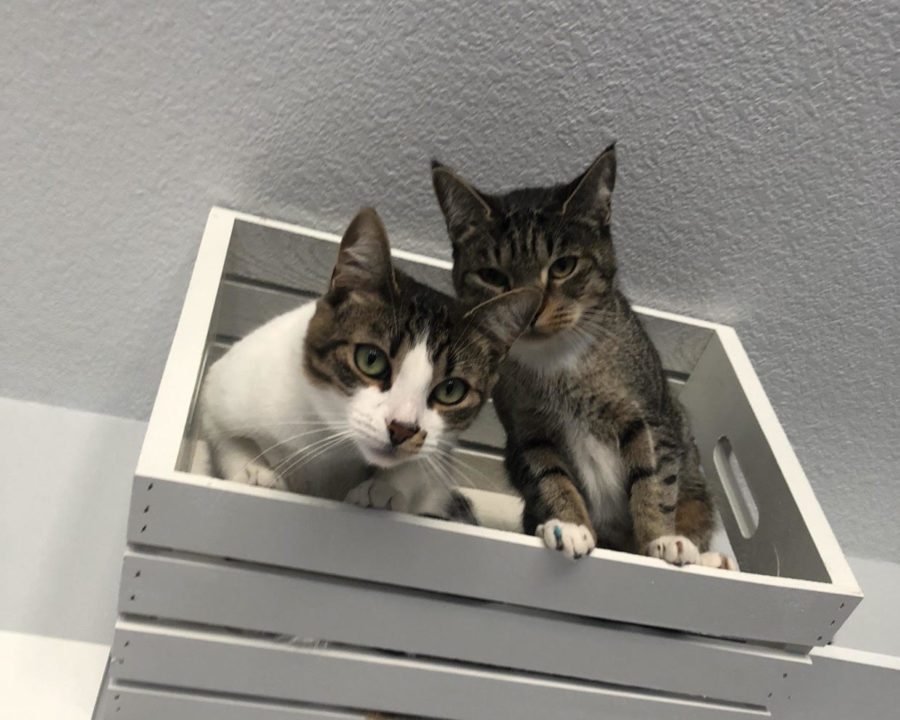How to Create Purr-fect Harmony Within Your Home
My two cats, Popps (brown tabby) and Dinner (white and brown tabby), who have become each other’s best friend after going through this introduction process together.
November 21, 2022
Cats can be complicated animals, especially within their relationships. When introducing your new feline family member, things can get messy as far as how the new and existing cats will react to one another. It can seem hopeless when your home is filled with cat fights and timeouts; however, there are some methods that may help your situation before giving up completely.
To start off, there are some things you should do before you bring another cat home. Always make sure you have a separate room (bathrooms or closets work just fine) prepared for your new kitty to stay in. Cats can be very skittish when in a new environment, so it’s important that they have their own safe space to reside in while they acclimate to their new home. Make sure you have the proper supplies, such as a litter box, food and water bowls, toys, a bed, and anything else that might ease their transition in that room with them. Another thing to always look out for when getting a cat is their health; take them to a vet to make sure they’ve been spayed/neutered, as well as that they have all their vaccinations up to date. It’s always important to make sure your kitty is happy and healthy, but it’s especially important to check when bringing them into a home with other animals or children. The last recommended thing to do beforehand is to start your existing cat on a scheduled feeding diet. This will come in handy with the introduction process, so set scheduled times a day to feed your cat instead of free feeding. Once you have the kitty “basecamp” all set up, and your cat is on a feeding schedule, you’re ready to bring your new pet home!
When you bring your new cat home, there are a few specific steps to follow in terms of introducing cats without sparking fights. The first thing you’ll want to start with is the scheduled feedings. Feed the two cats on opposite sides of the door, about 4 to 5 feet away from the door and never allowing for eye contact between the two. This will create a positive association with each other’s scent and feeding time. As this step progresses, and the cats are both able to finish their food without getting aggressive, you can begin to move the food bowls closer and closer to the door. In order for this step to be effective, there should be no contact with food for either cat without having some sort of contact with one another.
After you are able to move past the first step, it is time to create a whole new challenge: visual access. At this point, your cats should be able to finish their food with each food bowl touching either side of the door which separates them. This step requires you to take away the safety of the door, and replace it with something where they can see one another. You’ll continue the feedings as usual, still not having any contact with food unless with one another, except you’ll need a screen door, pet gate, or even a baby gate to separate the two. You won’t want to just throw them in the situation of being able to fully see each other, as that may spark aggression and unwillingness to participate. Instead, you’ll want to have a blanket (or sheet of some kind) over the door/gate being used. While they eat, you can slowly raise the blanket up so they can begin to see each other while still getting the positive reinforcement of food. Continue this until you are able to take the blanket away completely, with both cats still finishing their food each time. If there were no signs of aggression (i.e. hissing, growling, running away, or jumping) involved in the process, you’ll know this step was a success.
The final step to this introduction method takes a lot more effort on the owner’s part. Eat, Play, Love, a method coined by Jackson Galaxy (Feline Behaviorist). This step should be introduced only when the previous two steps have been successful in reducing tension between the two cats. When the two are at the stage where they can be in the same room, without barriers, have something for them to do. Whether it be giving them treats, playing with them, or showing them affection, keep them both busy on opposite sides of the room. As this step continues, they will build more and more positive feelings while around each other, which will result in them thinking something good will happen each time they’re together. This is the foundation of the relationship; they will grow as they get to know each other further.
These will all take time; depending on the cat, each step could take a couple days to a couple weeks. This whole method is based around the cat’s comfort level, and there’s no way to make a cat do something it doesn’t want to. The main goal here is to get your cats to tolerate each other. They don’t have to be best friends right away, as long as they aren’t getting into fights they should be able to build some sort of relationship past that on their own.
“Our pets are 100% worth the effort, we should always be willing to make changes that better suit their well being,” Hailey Whitehurst (10). Introducing my cats was a long process, taking about 6 months before they stopped fighting out of nowhere. Following this method helped us reduce stress in our home, eventually leading to the two being inseparable. When I asked a local animal shelter their professional opinion on the subject, they stated, “Every cat is different, given enough time and patience, you’d be surprised at the turn-arounds they are capable of,” Cats in Need (non-profit organization). Many cats have the ability to co-exist without any help, but in cases where they need a helping hand, I highly recommend giving this method a try. It could be just the thing your cats need.





































